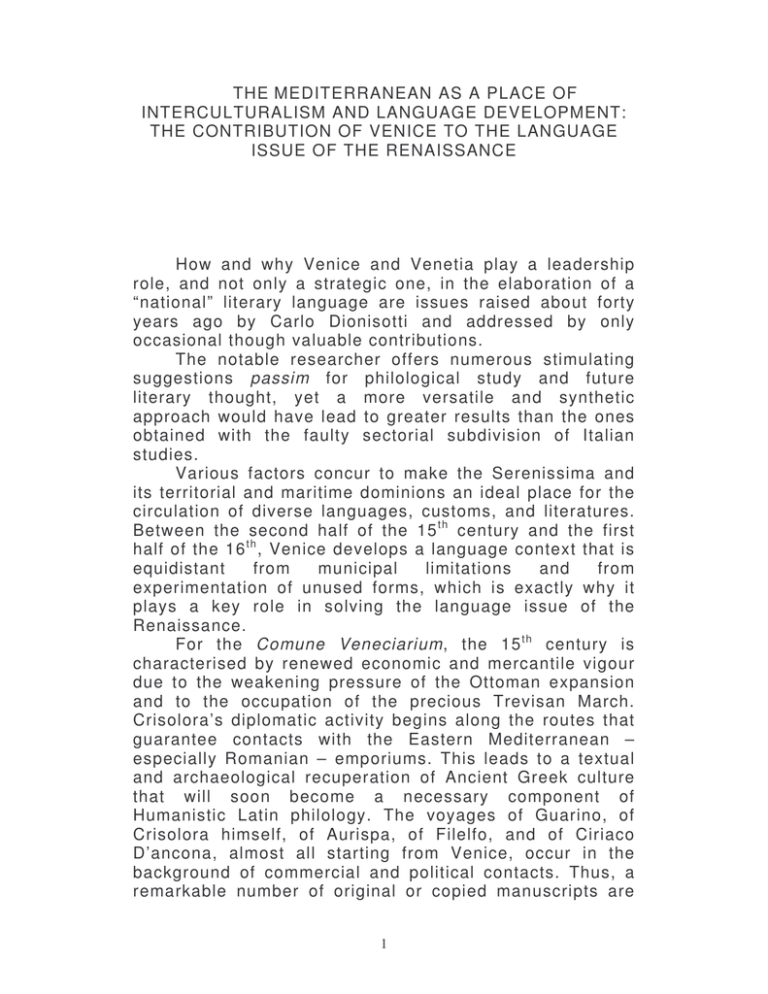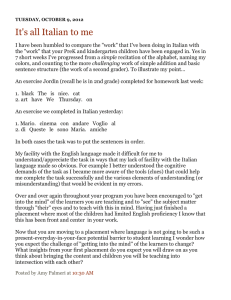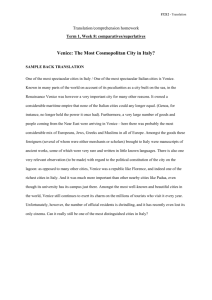THE MEDITERRANEAN AS A PLACE OF INTERCULTURALISM AND LANGUAGE DEVELOPMENT:
advertisement

THE MEDITERRANEAN AS A PLACE OF INTERCULTURALISM AND LANGUAGE DEVELOPMENT: THE CONTRIBUTION OF VENICE TO THE LANGUAGE ISSUE OF THE RENAISSANCE How and why Venice and Venetia play a leadership role, and not only a strategic one, in the elaboration of a “national” literary language are issues raised about forty years ago by Carlo Dionisotti and addressed by only occasional though valuable contributions. The notable researcher offers numerous stimulating suggestions passim for philological study and future literary thought, yet a more versatile and synthetic approach would have lead to greater results than the ones obtained with the faulty sectorial subdivision of Italian studies. Various factors concur to make the Serenissima and its territorial and maritime dominions an ideal place for the circulation of diverse languages, customs, and literatures. Between the second half of the 15 t h century and the first half of the 16 t h , Venice develops a language context that is equidistant from municipal limitations and from experimentation of unused forms, which is exactly why it plays a key role in solving the language issue of the Renaissance. For the Comune Veneciarium, the 15 t h century is characterised by renewed economic and mercantile vigour due to the weakening pressure of the Ottoman expansion and to the occupation of the precious Trevisan March. Crisolora’s diplomatic activity begins along the routes that guarantee contacts with the Eastern Mediterranean – especially Romanian – emporiums. This leads to a textual and archaeological recuperation of Ancient Greek culture that will soon become a necessary component of Humanistic Latin philology. The voyages of Guarino, of Crisolora himself, of Aurispa, of Filelfo, and of Ciriaco D’ancona, almost all starting from Venice, occur in the background of commercial and political contacts. Thus, a remarkable number of original or copied manuscripts are 1 taken to the Italian Peninsula at a rate that would have been unthinkable without the Venetian maritime routes. The Council of Ferrara-Florence (1438-42), stimulated by Byzantine desires for union with Venice due to the Turkish threat, enhances these acquisitions also on the patristic side: theological controversies are solved through fierce exegetical disputes where hermeneutic study on the Holy Scriptures and on the theological scriptures of the Fathers of the Church is essential, not to mention the Latin re-elaborations of the late Middle Ages. The Fall of Constantinople (1453) transforms the city into a crossroad through which Greek masters and intellectuals flee from Byzantium and flow into Italy, while the arrival of codes from Asia and Greece seems like an actual traslatio studii. Loads of manuscripts purchased or copied on commission are stored in important libraries giving vital energy to Greek Humanism. The Venetian library of Cardinal Bessarione is one of them. It is peculiar how Greek literature, which destabilises the primacy of Latin in humanistic culture at the end of the 15 t h century, is stimulated by Venetian commercial routes (the Adriatic routes and newer ones leading to Southern France by circumnavigating the peninsula and touching the main ports) and reaches the peak of its fruitful though indirect influence on the Italian language issue right where it began, with a surprising rebound effect. Over fifty years of philological research, sophisticated scholarly procedures, and fierce academic disputes represent the fertile ground that stimulates a complex and abundant printing activity prevalently in Venetia. Aldo Manunzio’s work is the most incisive outcome of the latter in the Greek field. Yet, fifty years of comparative study of Latin and Greek Classicism, of “imperfect bilingualism” by Humanist philologists, prepare the way for multilingual literature. The study of Hebrew in elite colleges and the revival of vernacular literature accompany and stimulate this multivocal character. Printing is a new multilingual “container” and amplifier, adjusting to a rapidly expanding and differentiating public. The Aldine cursives continue this tradition, with a taxonomic influence on Italian printing. The 16 th century begins not only with industrious, experimental editorial activity in the Dominion: the whole 2 intellectual class of Venice moves along the same routes of the previous century, and at the start of the 16 t h it represents the dynamic alternative to the Roman stronghold for Humanism and to the network of central and northern courts which continue a thriving literary tradition by producing the first examples of vernacular that rival with Latin. It would be, however, misleading to view the language issue exclusively within the rhetorical debate of a lively vernacular literature; it should rather be viewed within broader communication issues and strategies in the osmotic process of cultural integration between the various Italian centres. Increasing diplomatic and commercial relations between the Serenissima and the Italian regional system – by virtue of the unusual historical and political situation of this period – are linked with “territorial” curiosity and inclination towards language communication issues at many different levels of social life. Thus, it not surprising that Venetia represents a fertile terrain for the diffusion of religious reformation issues. In Padua, the Studium renews its activity after a brief period of closure and becomes an attraction for Italian, French, and German students participating to the new religious debates. In Venice, Lutheran preaching and underground circulation or lending of texts like the Unio Dissidentium already take place in the first two decades of the 16 t h century, among Patriarch Querini’s worries and Mons. Carafa’s complaints. Furthermore, the diffusion of Anabaptism and Erasmus’ didactic religious ideas is particularly vigorous and thrives in the more peripheral areas of the Dominion thanks to underground yet capillary devotion, and to the activity of some humanistic schools with pedagogic programs involving direct perusal in the original language of the Bible and of all the erudite and philosophical texts of the de rebus divinis. Reformation in Venetia does not lack language premises and consequences: it deeply influences the theological philosophy of Italian reformers, such as Iacopo Sadoleto and Marcantonio Flaminio who are main figures among them. Italian reformers are mainly humanists with a developed cult for rhetoric, education, and linguisticliterary institutions seen as mandatory steps for learning which must include religious awareness through direct and assiduous reading of the gospel. So it is clear how this 3 moral and religious renovation, which is actually felt more by the people than by the hierarchy of the Church, requires a language medium that can reconcile the need for solid rhetoric and grammar structures with other communication needs. The language model theorised by Pietro Bembo in Prose della Volgar Lingua could not have developed without these auspices, could not have avoided the influence of this tradition, could not have neglected the multiple and very diverse needs in the territory of Venetia. The intense amount of studies on the language issue indicates a mid and short range diachronic development of processes and theories in the first three decades of the 16 t h century which developed and determined the vernacular model: the great theoretic workshop being the 16 t h century language debates. These studies, however, do not value all those concomitant synchronic historical, political, and cultural causes in the widest sense. The latter indicate the Venetian Dominion as the only strategic area in the 15 t h and 16 t h centuries where commerce and epochal cultural fractures converge, with a traditionally open social structure interested in vernacular, and particularly with an aristocracy that is far from the merely academic spirit of Italian Humanism, preferring its more revolutionary ones in association to the religious renovation that will continue to spread throughout the whole European continent till the following century. ROSARIA BOTTARI 4


